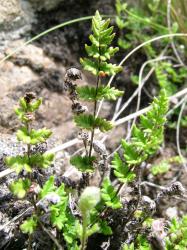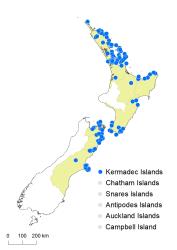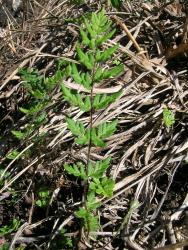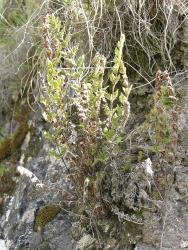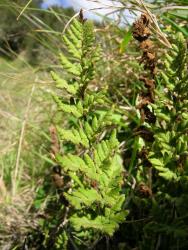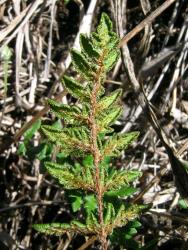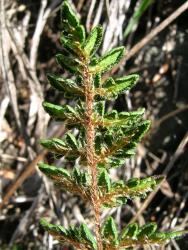- ≡ Notholaena distans R.Br., Prodr. Fl. Nov. Holland. 146 (1810)
- ≡ Hemionitis distans (R.Br.) Christenh. in Christenhusz et al., Global Flora, GLOVAP Nomenclature 1, 4, 13 (2018)
- = Cheilanthes ambigua Brack., U.S. Expl. Exped., Filic. 16, 91 (1854) nom. illeg., non Cheilanthes ambigua A.Rich. 1832
Rhizomes short- to long-creeping, up to 70 mm long (in herbarium specimens), 1–2 mm diameter, with stipes closely inserted; bearing appressed scales. Rhizome scales narrowly ovate, 1.5–3 mm long, 0.2–0.4 mm wide, dark brown with paler margins. Fronds monomorphic, 25–310 mm long, rarely to 400 mm long. Stipes 10–130 mm long, rarely to 150 mm long, erect, rigid, red-brown; bearing abundant narrowly ovate orange-brown scales, 2.5–4 mm long, 0.2–0.4 mm wide. Rachises red-brown, sulcate, densely scaly. Laminae 12–220 mm long, rarely to 260 mm long, 6–33 mm wide (sterile laminae sometimes slightly larger), 2-pinnate to 2-pinnate-pinnatifid, narrowly obovate or narrowly elliptic or linear, tapering to a pinnatifid apex, erect, dark green on both surfaces, coriaceous, bearing white hairs to 1 mm long on the adaxial surface, and abundant pale brown scales to 2.5 mm long, 0.3 mm wide on the abaxial surface. Primary pinnae in 6–18 pairs below pinnatifid apex, widely spaced especially proximally, ovate or broadly ovate; the longest near the middle, 3–25 mm long, 2–12 mm wide, apices acute, bases short-stalked, divided into secondary pinnae. Secondary pinnae decreasing in length along each primary pinna to the distal end; the longest secondary pinnae elliptic or ovate, 2–10 mm long, 1–4 mm wide, apices acute or obtuse, bases stalked or sessile, sometimes partially divided into tertiary segments. Sori almost continuous around pinna margins, protected by the inrolled margins. 16 spores per sporangium.
Cheilanthes distans is easily distinguished from other New Zealand species of this genus by its abundant covering of hairs on the adaxial lamina surface and narrowly ovate, pale brown scales on the abaxial surface. The laminae are also generally shorter, narrower and less divided than in C. sieberi (12–220 mm long cf. 30–250 mm long; 6–33 mm wide cf. 6–80 mm wide). The two species frequently occur together, and both are rigidly upright ferns.
North Island: Northland, Auckland, Volcanic Plateau, Gisborne, Southern North Island.
South Island: Sounds-Nelson, Marlborough, Canterbury.
Kermadec Islands
Altitudinal range: 0–600 m.
Cheilanthes distans has been collected once on Raoul Island in the Kermadec Islands. It occurs in lowland districts of the North Island from Te Paki to Wellington, largely confined to the eastern half of the island but apparently absent from much of Gisborne and northern Wairarapa. It grows from near sea level, mostly to c. 275 m, but has also been recorded from 600 m on Mt Pirongia. In the South Island it is confined to eastern areas from Tasman Bay to Banks Peninsula, growing from about 60 m, reaching 380 m on the Port Hills, Christchurch. It has also been observed near Separation Point in Abel Tasman National Park (see iNaturalist 5682101), but not yet collected from there, and not recorded on the distribution map.
Also Australia (Western Australia, South Australia, Queensland, New South Wales, Victoria, Tasmania), Norfolk Island, Lord Howe Island and New Caledonia.
Cheilanthes distans grows on dry cliffs, on rocky outcrops and scoria, on lava field, in rock crevices, on roadside banks and cuttings, and on grassy hillsides, often in sunny situations. It is found under kānuka, mānuka and scrub, often in coastal areas, and sometimes in full sun. It grows on volcanic rock, greywacke, sandstone and limestone substrates.
Together with Anogramma leptophylla, Asplenium flabellifolium, A. subglandulosum, Cheilanthes sieberi and Pellaea calidirupium, Cheilanthes distans forms a characteristic assemblage of ferns that inhabit dry rocky areas, especially in the eastern South Island.
2n = 116 (Murray & de Lange 2013). In Australia several counts indicate that plants are apomictic, with 84 univalents present at meiosis (Tindale & Roy 2002). There is also one count of 2n = c. 110 of a possibly apomictic plant (Quirk et al. 1983).



